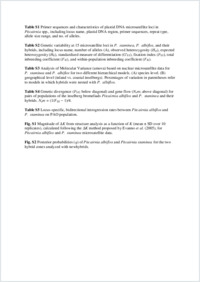Sympatric bromeliad species (Pitcairnia spp.) facilitate tests of mechanisms involved in species cohesion and reproductive isolation in Neotropical inselbergs
- Palma-Silva, Clarisse Jodrell Laboratory, Royal Botanic Gardens Kew, Richmond, Surrey, UK - Instituto de Botânica, São Paulo, Brazil
- Wendt, T. Departamento de Botânica, Rio de Janeiro, Brazil
- Pinheiro, Fábio Instituto de Botânica, São Paulo, Brazil
- Barbará, Thelma Jodrell Laboratory, Royal Botanic Gardens Kew, Richmond, Surrey, UK - Unit of Ecology and Evolution, Department of Biology, University of Fribourg, Switzerland
- Fay, Michael F. Jodrell Laboratory, Royal Botanic Gardens Kew, Richmond, Surrey, UK
- Cozzolino, Salvatore Dipartimento di Biologia Strutturale e Funzionale, Università degli Studi di Napoli, Italy
- Lexer, Christian Unit of Ecology and Evolution, Department of Biology, University of Fribourg, Switzerland
-
15.06.2011
Published in:
- Molecular Ecology. - 2011, vol. 20, no. 15, p. 3185–3201
biodiversity
bromeliad
chloroplast sharing
hybridization
intraspecific gene flow
introgression
microsatellite
population genetics
English
The roles of intra- and interspecific gene flow in speciation and species evolution are topics of great current interest in molecular ecology and evolutionary biology. Recent modelling studies call for new empirical data to test hypotheses arising from the recent shift from a ‘whole-genome reproductive isolation’ view to a ‘genic’ view of species and speciation. Particularly scarce (and thus of particular interest) are molecular genetic data on recently radiated, naturally hybridizing species in strongly structured and species-rich environments. Here, we studied four sympatric plant species (Pitcairnia spp.; Bromeliaceae) adapted to Neotropical inselbergs (isolated outcrops resembling habitat ‘islands’ in tropical rainforests) using nuclear and plastid DNA. Patterns of plastid DNA haplotype sharing and nuclear genomic admixture suggest the presence of both, incomplete lineage sorting and interspecific gene flow over extended periods of time. Integrity and cohesion of inselberg species of Pitcairnia are maintained despite introgression and in the face of extremely low within-species migration rates (Nem < 1 migrant per generation). Cross-evaluation of our genetic data against published pollination experiments indicate that species integrity is maintained by the simultaneous action of multiple prezygotic barriers, including flowering phenology, pollinator isolation and divergent mating systems. Postzygotic Bateson–Dobzhansky–Muller incompatibilities appear to contribute to isolation, as suggested by asymmetric introgression rates of single loci. Our results suggest that incomplete lineage sorting, hybridization and introgression form integral aspects of adaptive radiation in Neotropical inselberg ‘archipelagos’. Inselbergs with multiple closely related co-occurring species should be of special interest to students of speciation in mountain systems, and to ongoing conservation programmes in the Atlantic Rainforest biodiversity hotspot.
- Faculty
- Faculté des sciences et de médecine
- Department
- Département de Biologie
- Language
-
- English
- Classification
- Biological sciences
- License
- License undefined
- Identifiers
-
- RERO DOC 24838
- DOI 10.1111/j.1365-294X.2011.05143.x
- Persistent URL
- https://folia.unifr.ch/unifr/documents/302111
Other files
Statistics
Document views: 114
File downloads:
- lex_sbs.pdf: 215
- lex_sbs_sm.pdf: 100

